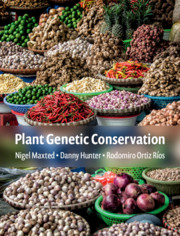Book contents
- Frontmatter
- Frontispiece
- Contents
- Foreword
- Preface
- Acknowledgements
- Part I Introduction
- Part II Scientific Background
- Part III Conservation Practice
- 6 Planning Plant Conservation
- 7 Conservation Strategies and Techniques
- 8 In Situ Conservation
- 9 On-Farm Conservation
- 10 Community-Based Conservation
- 11 Germplasm Collecting
- 12 Seed Gene Bank Conservation
- 13 Whole Plant, Plantlet and DNA Conservation
- Part IV Plant Exploitation
- Acronyms and Abbreviations
- Glossary
- References
- Index
- Plate section
9 - On-Farm Conservation
from Part III - Conservation Practice
Published online by Cambridge University Press: 05 September 2020
- Frontmatter
- Frontispiece
- Contents
- Foreword
- Preface
- Acknowledgements
- Part I Introduction
- Part II Scientific Background
- Part III Conservation Practice
- 6 Planning Plant Conservation
- 7 Conservation Strategies and Techniques
- 8 In Situ Conservation
- 9 On-Farm Conservation
- 10 Community-Based Conservation
- 11 Germplasm Collecting
- 12 Seed Gene Bank Conservation
- 13 Whole Plant, Plantlet and DNA Conservation
- Part IV Plant Exploitation
- Acronyms and Abbreviations
- Glossary
- References
- Index
- Plate section
Summary
On-farm conservation involves the maintenance of traditional varieties by farmers in agroecosystems. The important role of small farmers living and cultivating in complex, diverse and risk-prone marginal and heterogeneous environments in maintaining crop diversity on-farm is described. The on-farm conservation of plant genetic resources is complex because there are many factors that will influence a farmer’s decision on the management of their crops and fields, which in turn affect the quantity and quality of the inherent genetic diversity. The multiple private and public values and benefits of on-farm conservation are highlighted, as well as the options and interventions that can help strengthen the role of small farmers and farming communities in on-farm conservation. A major focus for the conservationist or development practitioner will be to encourage the farmer to continue cultivation of traditional varieties and this may be achieved by niche marketing, seed shows, participatory traditional variety improvement or even financial incentives. Key steps that need to be considered when implementing an on-farm conservation project are outlined and a brief review of the impact of on-farm conservation projects and the implications for scaling up actions is provided.
Keywords
- Type
- Chapter
- Information
- Plant Genetic Conservation , pp. 249 - 277Publisher: Cambridge University PressPrint publication year: 2020

